If `y=log((1x^2)/(1x^2))` , then `(dy)/(dx)=` (a)`(4x^3)/(1x^4)` (b) `(4x)/(1x^4)` (c) `1/(4x^4)` (d) `(4x^3)/(1x^4)` Find the length and mass of the wire, assuming the density of copper to be The cost of painting the total outside surface of a closed cylindrical oil tank at 60 paise per sq dm is Rs The height of the y = log( ( 1 – x 2) / ( 1 x 2) ) Or y = log( 1 – x 2) – log( 1 x 2) log(a/b) = loga – logb Now differentiating , dy/dx = ( 1/ 1 x 2) ( d/dx( 1 x 21 Inform you about time table of exam 2 Inform you about new question papers 3 New video tutorials information

If Xy Log X Y 1 Prove That Dydx Y X 2y X Y X Xy 2 X Y
Y=log(1-x^2/1 x^2) find dy/dx
Y=log(1-x^2/1 x^2) find dy/dx- `dy/dx=1/(xy log10)cdot(yx cdot dy/dx)` In the line above we have applied the chain rule because `log(xy)` is a composite function On top of that we have applied product rule for `xy` to get Find dy/dx, if y=log sin x^2 neha287 neha287 Math Secondary School answered Find dy/dx, if y=log sin x^2 2 See answers chiyal chiyal Dy/dx =( 1/sinx^2 ) cosx^2 2x plz fir se SYED777 SYED777 Y=log sin x^2= dy/dx=1/sin x^2(cos x^2)(2x)=2x cot x^2 plz fir se btao pura solution
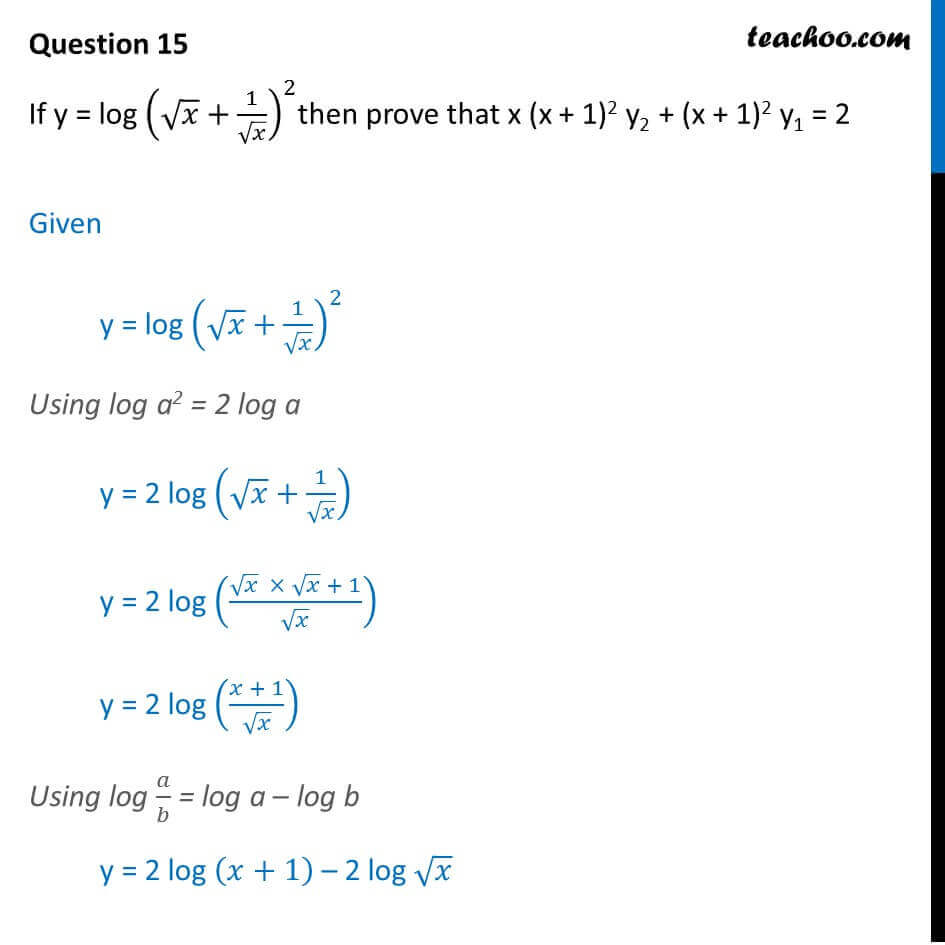



If Y Log Root X 1 Root 2 Then Prove X X 1 2 Y2 X 1 2 Y1
The derivative of the function `y = log(x 1/x)` with respect to x, `dy/dx` has to be determined It is assumed that log in the problem refers to natural logarithmQuestion 1) Find Dy/dx Given That Y = (x^2 1) / (x^21) 2) Find Dy/dx Given That Y = (x^2 1) / (x^21) This problem has been solved! If xy = ex y, then prove that dy/dx = (log x)/(1 log x)2 Welcome to Sarthaks eConnect A unique platform where students can interact with teachers/experts/students to get solutions to their queries
If y = log √(tan x), then the value of dy/dx at x = π/4 is given by A ∞ B 1 C 0 D 1/2 asked Apr in Differentiation by Kaina ( 304k points) differentiation4 years ago By rearranging the give differential equation we get , dx/dy =1/y x/ (ylogy) dx/dy x/ (ylogy) =1/y Now, calculate the integrating factor (IF), e ∫1/ (ylogy) =IF Taking, logy=t (say) differentiating on both sides we get, dy=ydt IF=e ∫dt/t =e logt =t, where t=logy now, solving in linear differential equation formMATHS Find arc length of y=logx from x=1 to x=2 dy/dx)^2=1/x^2 arc length=Int of sqrt(11/x^2)dx =Int of sqrt(1x^2)/x^2 =Int of sqrt(1x^2)/x from x=1 to x=2
Find the area of the sector bounded by this arc and the radii from A and B Mathematics An arc substend an angle of 105 degree at d centre of a circle of radius 6cm find the length of the arc if pi 22/7 Bobby Find the length (in cm) of an arc of a circle with radius 12 cm if the arc subtends a central angle of 30°97 EXERCISE 35 Q1 Find dy dx if, 1) x = at 2, y = 2 at 2) x = 2 at 2, y = at 4 3) x = e 3 t, y = e (4 t 5) Q2 Find dy dx if, 1) x = u u g14 g167 g169 g168 g1 g185 g184 1 2, y = 2 1 g11 g12 g14 g167 g169 g168 g1 g185 g184 u u 2) x = 1 2 u, y = log(1 u 2) 3) Differentiate 5 x with respect to log x Q3 Solve the followingIf Y Log Tan X 2 Find Dy Dx Brainly In For more information and source, see on this link https//brainlyin/question/




If Y Log 5x Square 3x 2 Then Find Dy By Dx Brainly In




If Y Log 1 X 2 1 X 2 Then Dy Dx Is Equal To
Watch the complete video at https//doubtnutapplink/LdLpxMIf `y=logxsqrt(x^2a^2)\\ `, show that (`(x^2a^2)(d^2\\ y)/(dx^2)x(dy)/(dx)=0`CLASS 12,CL(1) 2/x 2 2/x 3 (2) 2/x 3 1/x 2 (3) 2/x 2 2/x 2 (4) none of these Solution Given y = (1 – x)/x 2 = 1/x 2 – 1/x Differentiate wrtx dy/dx = 2/x 3 – (1/x 2) = 2/x 3 1/x 2We have math\dfrac{d}{dx}\log (x \sqrt{1 x^2})/math math= \displaystyle\dfrac{1}{(x \sqrt{1 x^2})} \dfrac{d}{dx}(x \sqrt{1 x^2})/math math
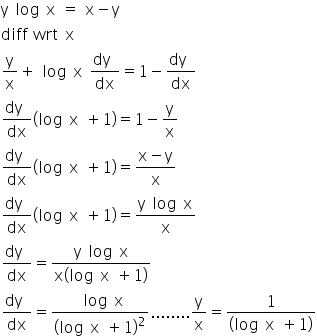



If Y Log X X Y Prove That Dy Dx Log X 1 Log X 2 Mathematics Topperlearning Com 2dolmeyy




If Y Log X Sqrt X 2 A 2 Show That X 2 A 2 D 2y Dx 2 X Dy Dx 0 Youtube
Compute answers using Wolfram's breakthrough technology & knowledgebase, relied on by millions of students & professionals For math, science, nutrition, historyIn calculus, Leibniz's notation, named in honor of the 17thcentury German philosopher and mathematician Gottfried Wilhelm Leibniz, uses the symbols dx and dy to represent infinitely small (or infinitesimal) increments of x and y, respectively, just as Δx and Δy represent finite increments of x and y, respectively Consider y as a function of a variable x, or y = f(x) Explanation Using the chain rule d dx f (g(x)) = f '(g(x))g'(x) and the standard derivative d dx (logx) = 1 x dy dx = 1 x2 1 d dx (x2 1) = 2x x2 1 Answer link




Find Dy Dx Y X 2 1 Log X Chegg Com




Y Log 1 X 1 X Find Dy Dx Brainly In
Let y =(log x) x x log x Also, let u =(log x) x and v = x log x ∴ y = u v `⇒"dy"/"dx" = "du"/"dx""dv"/"dx"` (1) u = (logx) x ⇒ log u = log(log x) xShow that the function phi (x) = (c^2 x^2)^1 is a solution to the initial value problem dy/dx = 2xy^2, y (0) = 1/c^2, on the interval c < x < c Note that this solution becomes unbounded as x approaches plusminus c Thus, the solution exists on the interval ( delta, delta) with delta = c, but not for larger deltaCalculus Find dy/dx y^2=1/ (1x^2) y2 = 1 1 − x2 y 2 = 1 1 x 2 Differentiate both sides of the equation d dx (y2) = d dx ( 1 1−x2) d d x ( y 2) = d d x ( 1 1 x 2) Differentiate the left side of the equation Tap for more steps
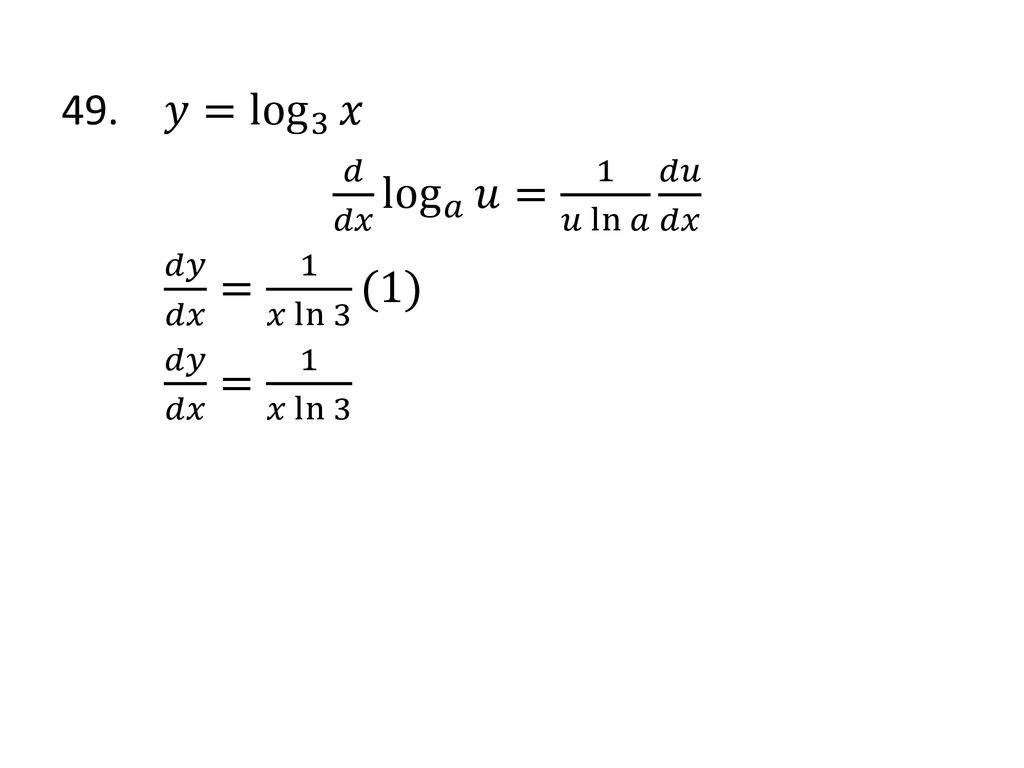



Derivatives Of Ppt Download



What Is The Derivative Of E Log 1 Tan 2 X Quora
4 The derivative of an even function is always 1 an odd function 2 an even function 3 does not existSolve your math problems using our free math solver with stepbystep solutions Our math solver supports basic math, prealgebra, algebra, trigonometry, calculus and moreHomework Equations The Attempt at a Solution




If Y Log Sin X Sqrt X 2 1 Find Dy Dx Youtube
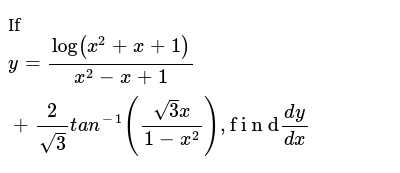



If Y Log X 2 X 1 X 2 X 1 2 Sqrt 3 T A N 1 Sqrt 3 X 1 X
Y = log7 logx y = loge 7loge logx dxdy = loge 71 (logx 1 ) dxd logxdxdy = loge 71 logx1 x1 dxdy = loge 7xlogx1 ∴ dxdy = loge 7xlogx1 Homework Statement rewrite the equation in the form of linear equation Then solve it (1x^2)dy/dx xy = 1/ (1x^2) the ans given is y= x/ (1x^2) C / ( sqrt rt (1x^2) ) , my ans is different , which part is wrong ? Example 9 Find the general solution of the differential equation 𝑑𝑦/𝑑𝑥= (𝑥1)/ (2−𝑦) , (𝑦≠2) 𝑑𝑦/𝑑𝑥= (𝑥 1)/ (2 − 𝑦) , (𝑦≠2) (2 − y) dy = (x 1) dx Integrating both sides ∫1 〖 (2−𝑦)𝑑𝑦=〗 ∫1 (𝑥1)𝑑𝑥 2y − 𝑦^2/2 = 𝑥^2/2 x c 〖4𝑦 − 𝑦〗^2/2 = (𝑥



Www Math Colostate Edu Clayton Teaching M113f10 Homework Hw7solutions Pdf




Engineering Mathematics Notes
Answer to Solve the differential equation xdy/dx y = xlog x By signing up, you'll get thousands of stepbystep solutions to your homeworkCOMEDK 08 If y = sin1 ((5x12 √1 x2/13)) , then (dy/dx) = (A) (3/√1 x2) (B) (12/√1 x2) (1/√1 x2) (D) (1/√1 x2) Check AKCET 15 If y= log ( (1x2/1x2)) then (dy/dx) is equal to (A) (4x/1x4) (B) (4x3/1x4) (1/4x4) (D) (4x3/1x4) Check Answer and Solut




If Xy Log X Y 1 Prove That Dydx Y X 2y X Y X Xy 2 X Y



5 Derivative Of The Logarithmic Function
If y = (sin x) x sin1 (x) 1/2, find dy/dx Mention each and every step find dy/dx y = (log x) x (x) log x mention each and every formula and minute details find dy/dx mention each and every formula and minute steps and detail Y = x x e (2x 5) Differentiate x sinx w r to xVerify that x^2 cy^2 = 1 is an implicit solution to \frac {dy} {dx} = \frac {xy} {x^2 1} If you're assuming the solution is defined and differentiable for x=0, then one necessarily has y (0)=0 In this case, one can easily identify two trivial solutions, y=x and y=x If you're assuming the solution is defined and Ex 53, 11 Find 𝑑𝑦/𝑑𝑥 in, 𝑦 = cos–1 ((1− 𝑥^2)/( 1 𝑥2 )) , 0 < x < 1 𝑦 = cos–1 ((1− 𝑥^2)/( 1 𝑥2 )) Putting x = tan θ y




If Y Log 1 X1 X 1 4 12tan 1x Then Dydx Is Equal To



If Xy E X Y Then Prove That Dy Dx Log X 1 Log X 2 Sarthaks Econnect Largest Online Education Community
Share with your friends Share 3 Follow 8 Manbar Singh, Meritnation Expert added an answer, on Manbar Singh answered this We have, y = log x cos x x 2 1 x 2 1 Let y = u v where u = log x cos x and v = x 2 1 x 2 1 Now, y = u v ⇒ dy dx = du dx dv dx 1 Let u = log x cos x ⇒ log u = cos x log log x ⇒ 1 u if y = log tan (∏/4 x/2) show that dy/dx = sec x donot go shortcut if y = log (x (1 x 2) 1/2 ) prove that dy/dx = 1/log (x (1 x 2) 1/2) 1/ (1 x 2) 1/2 Find dy/dx y = x x e (2x 5) mention each and every step Find dy/dx (x) 1/2 (y) 1/2 = (a) 1/2 Mention each and every step If y = tan 1 a/x log (xa/xa) 1/2, proveFind d2y/dx2 where y=log(x^2/e^2) y=log(x 2 /e 2 ) diff wr to x , we get dy/dx=1/(x 2 /e 2 ) (2x/e 2 ) =2/x diff wr to x again d 2 y/dx 2 =2/x 2 Thank




Find Dy Dx When Y E Xlog 1 X 2
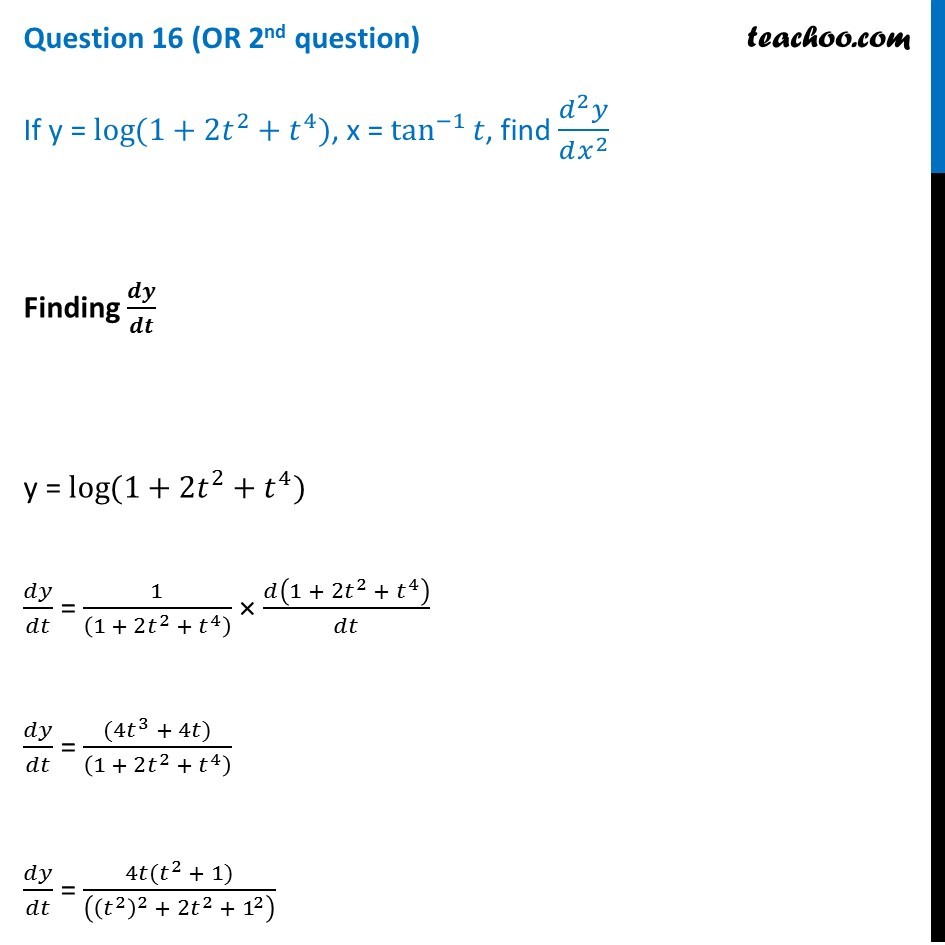



If Y Log 1 2t 2 T 4 X Tan 1 T Find Y Teachoo
Find dy/dx y = natural log of x^2 y = ln (x2) y = ln ( x 2) Differentiate both sides of the equation d dx (y) = d dx (ln(x2)) d d x ( y) = d d x ( ln ( x 2)) The derivative of y y with respect to x x is y' y ′ y' y ′ Differentiate the right side of the equation Tap for more steps Differentiate using the chain rule, which states thatClick here👆to get an answer to your question ️ If y = log ( 1 x^21 x^2 ) , then dydx is equal to Join / Login > 12th > Maths > Continuity and Differentiability > Derivative of Exponential and Logarithmic Functions If y = lo g (1 x 2 1Answer to Use logarithmic differentiation to find frac{dy}{dx} y =sqrt{frac{x^21}{x^21}} By signing up, you'll get thousands of stepbystep




If Y Log Tan X 2 Find Dy Dx




1 If Y Sqrt X 2 1 Log 1 X Sqrt 1 1 X 2 Find Dy Dx 2 Find The Equation Of Tangent To The Curve Y Sqrt 4x 2 Which
Find dy/dx if y = log(sin x) Get the answer to this question and access a vast question bank that is tailored for students1 and x 2 While it may not be possible to explicitly solve for y as a function of x, we can still find the effect on y from a change in x 1 or x 2 by applying the implicit function theorem Theorem 9 If a function F(y,x 1,x 2)=0 has well defined continuous partial derivatives ∂F ∂y = F y ∂F ∂x 1 = F x 1 ∂F ∂x 2Why create a profile on Shaalaacom?



How To Find Dy Dx Of The Function Y X 1 X 2 X 1 2 Quora




Y Log X Root 1 X2 Prove That 1 X2 D2y Dx2 X Dy Dx 0 Brainly In
UP Primary and Upper Primary Schools to Reopen from 01 July UP state government has ordered that 15 lakh government primary and upper primary schools across the state will reopen from 01st July 21 CBSE Class 12 evaluation Criteria Class 10, 11 & 12 marks in ratio CBSE class 12 evaluation criteria is out95 ∴ dy dx = x xy y y xy x 2 2 2 2 2 2 g14 g14 g11 g12 g16 g16 g11 g12 2) Find dy dx if x y = y x Solution Given x y = y x Taking logarithm of both sides, we get ∴ y log x = x log y Differentiating both sides with respect to x, we get ∴
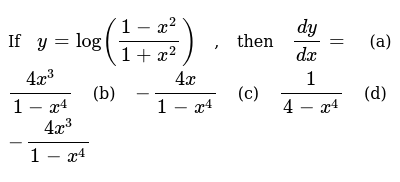



If Y Log 1 X 2 1 X 2 Then Dy Dx A 4x 3 1 X 4



Y Log X X 2 A 2




If Y Log X Sqrt 1 X 2 Prove That Sqrt 1 X 2 Dy Dx 1 Youtube



1
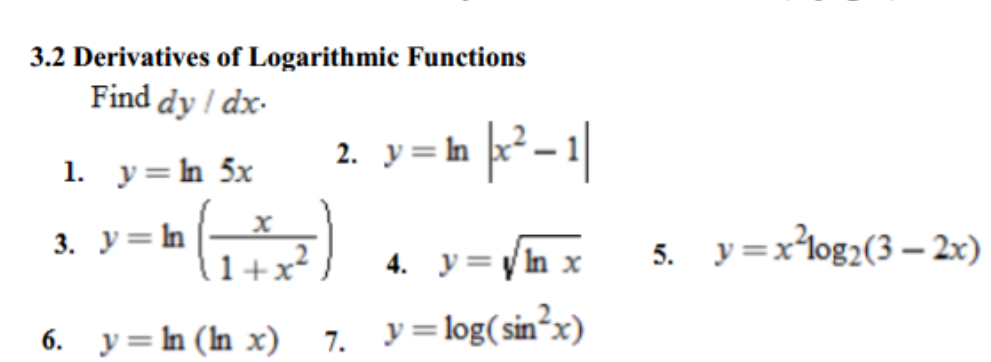



Derivatives Of Logarithmic Functions Find Dy Dx Y Chegg Com




If Y Log 1 X 2 1 Then Find Dy Dx Replying




Mathematics Statistics 1 Pages 101 150 Flip Pdf Download Fliphtml5



If Y Log X X 2 A 2 X 2 A 2 X Find Dy Dx Sarthaks Econnect Largest Online Education Community
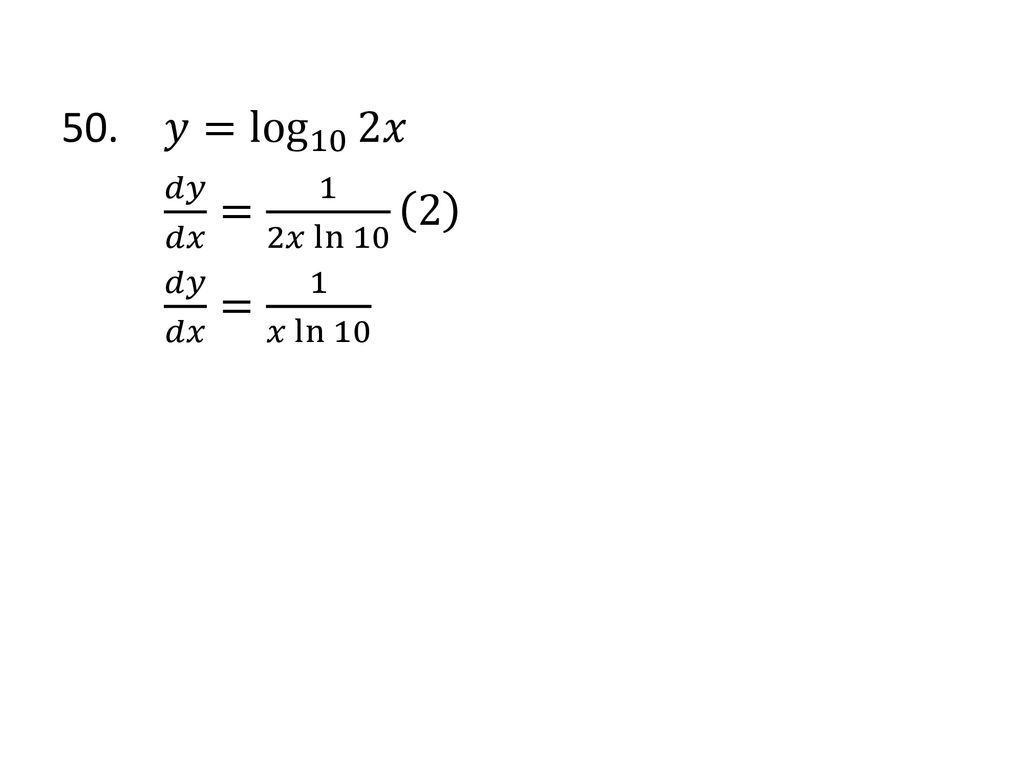



Derivatives Of Ppt Download
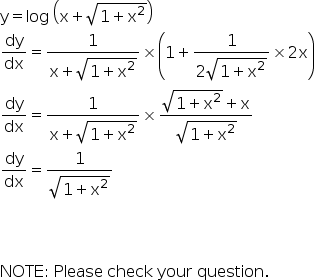



If Y Log X 1 X2 1 2 Prove That Dy Dx 1 Log X 1 X2 1 2 1 1 X2 1 2 Mathematics Topperlearning Com Qsw6n0xx



What Is The Derivative Of Log X 1 X Quora




If Y Log 1 X 1 X 1 4 1 2tan 1 X T H E N Dy Dx Youtube




If Y Log X Root X2 1 Then Prove That X2 1 Dy Dx X Dy Dx 0 Brainly In



1



Y Log X X 2 1 2




If Y X 2 1 Log X 2 1 X Show That X 2 1 Dydx Xy 1 0



5 Derivative Of The Logarithmic Function




Y Sqrt X 2 1 Log 1 X Sqrt 1 1 X 2 Find Dy Dx Youtube




Ex 6 2 7 Ex 6 2




Derivative Of Logarithm For Any Base Old Video Khan Academy
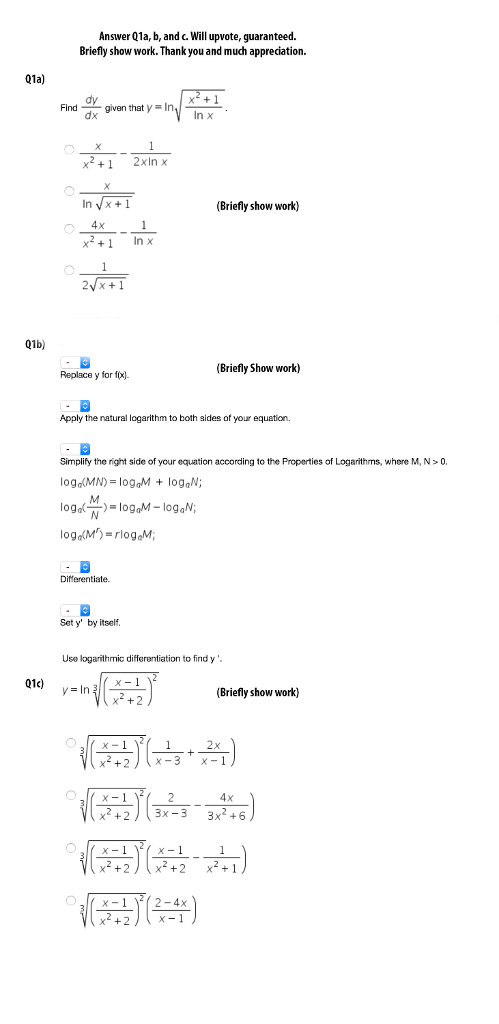



Find Dy Dx Given That Y Ln Squareroot X 2 1 Ln X Chegg Com




If Log X Y Log 2 1 2logx 1 2 Logy Then Youtube




Ex 9 6 7 Find General Solution X Log X Dy Dx Y 2 X Log X




If Y Log 1 Sin 2x 1 Tanx Find Dy Dx Maths Continuity And Differentiability Meritnation Com




If Y Log Sqrt 1 X 2 X Sqrt 1 X 2 X Then




If X T Log T And Y Log T T Find Dy Dx For T 1 Brainly In




Mathematics Statistics 1 Pages 101 150 Flip Pdf Download Fliphtml5




If Y Log X 2 X 1 X 2 X 1 2 Sqrt 3 T A N 1 Sqrt 3 X 1 X



5 Derivative Of The Logarithmic Function




Rd Sharma Class 12 Maths Solutions Chapter 11 Differentiation




Solution Differentiate Y Log 10 X 2 2 2




If Y Log Root X 1 Root 2 Then Prove X X 1 2 Y2 X 1 2 Y1



If Y X 2 1 Log 1 X 1 1 X 2 Find Dy Dx Sarthaks Econnect Largest Online Education Community
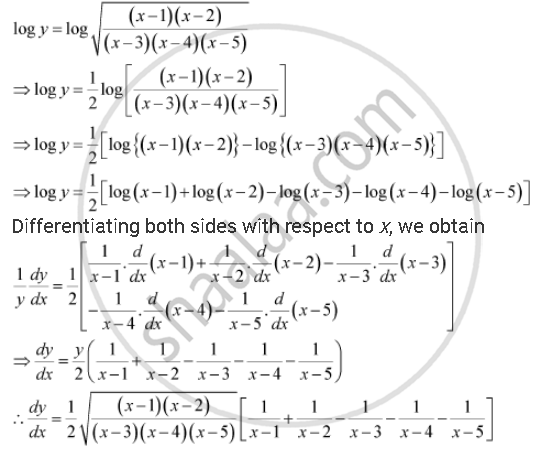



Differentiate The Function With Respect To X Sqrt X 1 X 2 X 3 X 4 X 5 Mathematics Shaalaa Com




Find Dy Dx Of The Next Relations Sol Y Ylx 1 1 Cx C 2 1 Cx Y 39 1 Cx1 Cx A Bx Ab 3 Y In Va Bx Y 39 S B Homeworklib




Mathematics Statistics 1 Pages 101 150 Flip Pdf Download Fliphtml5




If Y Log X Logx Then Dy Dx Youtube




Integral Int 1 1 Frac1x Sqrt Frac 1 X 1 X Ln Left Frac 2 X 2 2 X 1 2 X 2 2 X 1 Right Mathrm Dx Mathematics Stack Exchange




Derivative Of Logₐx For Any Positive Base A 1 Video Khan Academy




If Y Log X Sqrt X 2 1 Prove That X 2 1 D 2 Y Dx 2 X Dy Dx 0 Youtube



If Y Log 1 Cos X 1 Cos X How Can You Prove That Dy Dx 2cosec X Quora




If Y Logx Cosx X 2 1 X 2 1 Find Dy Dx Maths Continuity And Differentiability Meritnation Com
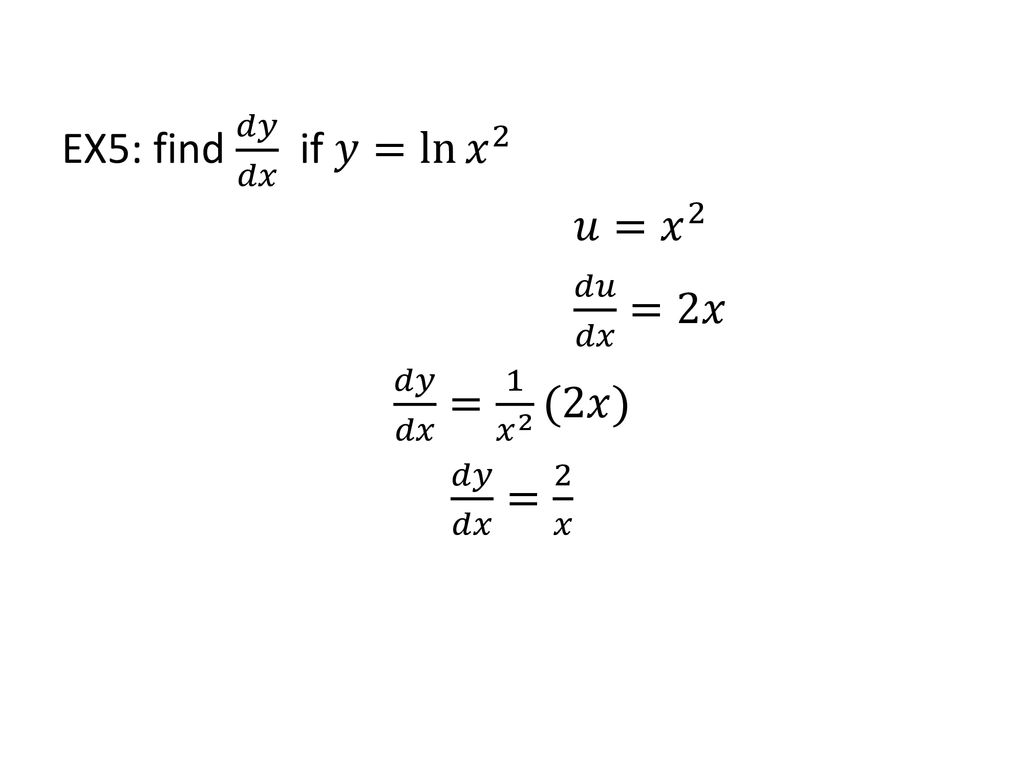



Derivatives Of Ppt Download
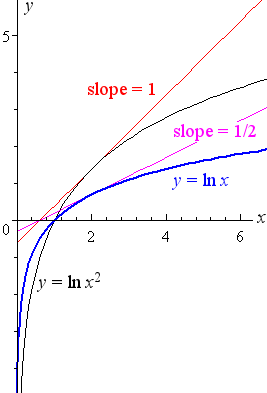



5 Derivative Of The Logarithmic Function




Mp Board Class 12th Maths Important Questions Chapter 5b Differentiation Mp Board Solutions



What Will Be The Value Of D Dx Log 1 X 2 Quora




If Y Log 1 1 X Then 1 Dy Dx



If Y X 2 1 Log 1 X 1 1 X 2 Find Dy Dx Sarthaks Econnect Largest Online Education Community




If Y Log 1 X 2 1 X 2 Then Find Dy Dx Maths Meritnation Com



7 3 General Exponential And Logarithmic Functions



How To Solve X 3d 3 2x 2d 2 Xd 1 Y Log X Euler S Type Quora




If Y Log 1 X 2 1 X 2 Then Dy Dx A 4x 3 1 X 4




Finding The Derivative Of Log X Video Lesson Transcript Study Com
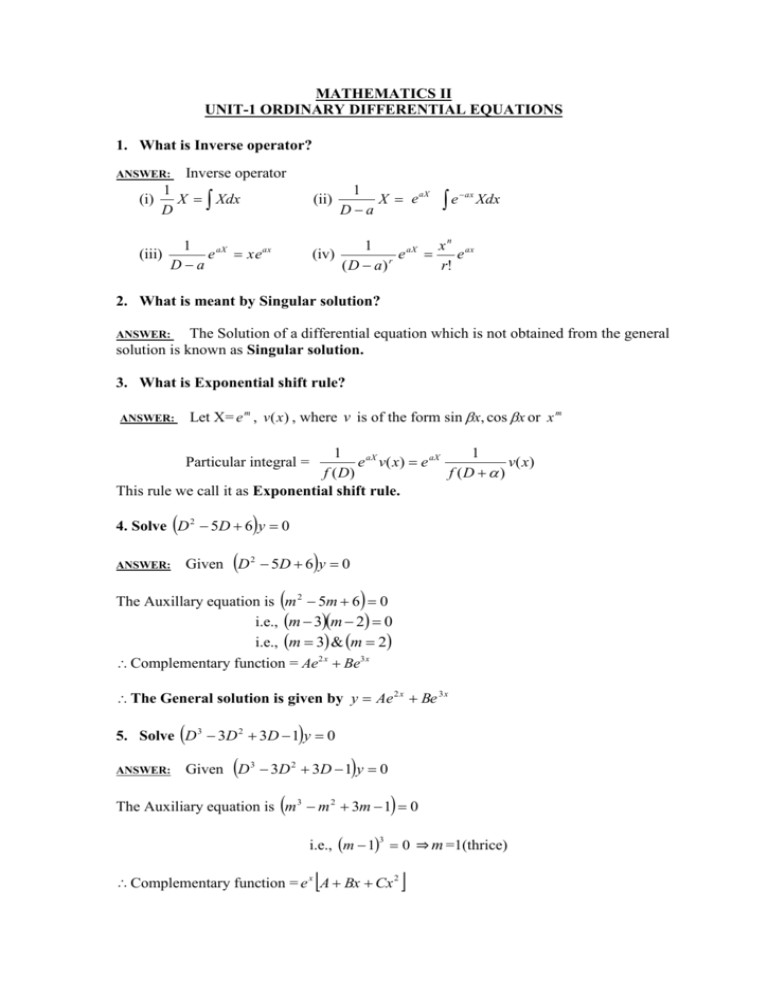



Mathematics Ii Tranquileducation




Finding The Derivative Of Log X Video Lesson Transcript Study Com
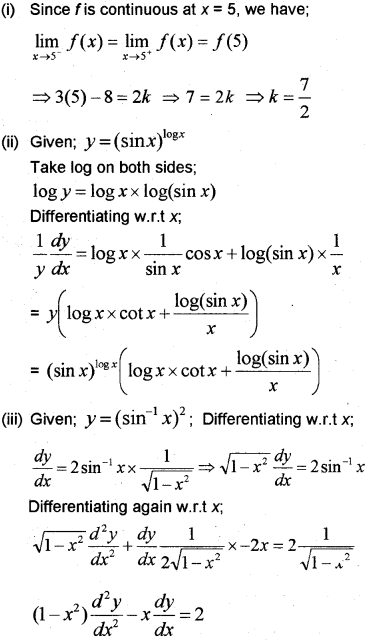



Plus Two Maths Chapter Wise Previous Questions Chapter 5 Continuity And Differentiability A Plus Topper




Find Dfrac Dy Dx When Y Dfrac X 2 Sqrt 1 X 1 X 2 32




Solve 1 X 2 D 2y Dx 2 X Dy Dx Y X 1 X 2 3 2 Mathematics 2 Question Answer Collection



If Y X Is A Solution Of 2 Sinx 1 Y Dy Dx Cosx And Y 0 1 Then Find The Value Of Y P 2 Studyrankersonline



What Is The Differentiation Of Log X 2 1 X 2 1 W R T X Quora



Www Tau Ac Il Levant Ode Solution 6 Pdf




Engineering Mathematics Notes



What Is The Differentiation Of Log X 2 1 X 2 1 W R T X Quora
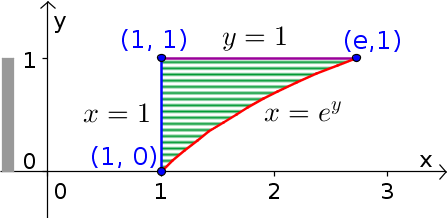



Examples Of Changing The Order Of Integration In Double Integrals Math Insight




Can Anyone Please Help Me Do This If Log X Aˆs 1 X2 2 Show That 1 X2 D2y Dx2 X Dy Dx 2 0 Maths Differential Equations Meritnation Com




Hi My Question Is If Y Log X 1 X 2 1 2 2 Find Dy Dx And D 2y Dx 2 Maths Continuity And Differentiability Meritnation Com




Q47 If Y Log X X 2 1 Then Prove That X 2 1 D 2 Y Dx 2 X Dy Dx 0 2nd Order Derivatives Youtube




If Y Log 1 X 2 1 Then Find Dy Dx Replying




Ex 9 6 7 Find General Solution X Log X Dy Dx Y 2 X Log X




Y Log X Sqrt X 2 25 Sqrt X 2 25 X F I N D Dy Dx



If Yx Ey X Prove That Dy Dx 1 Log Y 2 Log Y Studyrankersonline




If Y Log X X Y Then Prove Dy Dx Log X 1 Log X 2 Brainly In




Ex 5 5 7 Differentiate The Function Log X X X Log X




Dy 3 Find Dx A Y 24 Log X2 1 C Y In X In X Chegg Com



5 Derivative Of The Logarithmic Function




Implicit Differentiation Advanced Example Video Khan Academy



Differentiate Log X X2 A W R T X Studyrankersonline




Differentiate The Function With Respect To X X Xcosx X 2 1 X 2 1 Mathematics Shaalaa Com




If Y Log 1 Cos2 X 1 E2x 1 2 Show That Dy Dx E2x 1 E2x Sin X Cos X 1 Cos2 X Show Each And Every Step Mathematics Topperlearning Com Idjkxezz
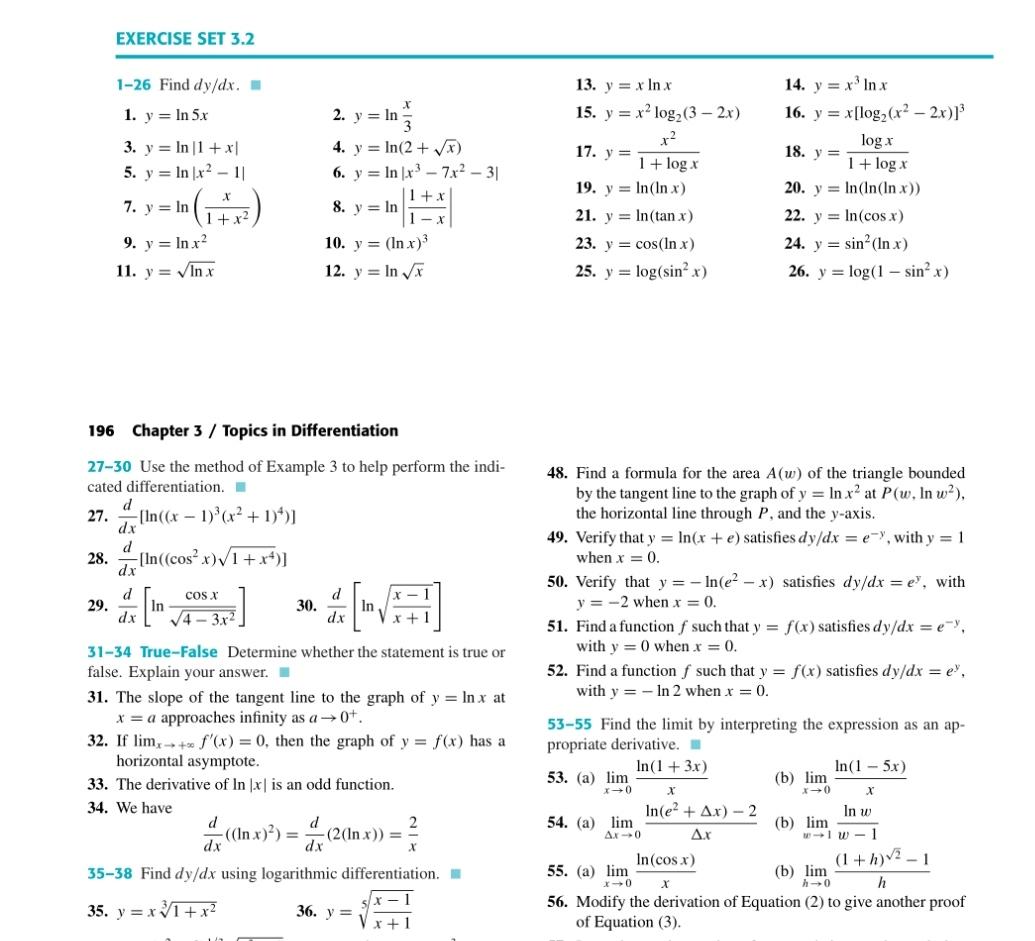



Section 3 1 6 9 16 25 Section 3 2 7 11 15 Chegg Com




1 If Y Sqrt X 2 1 Log 1 X Sqrt 1 1 X 2 Find Dy Dx 2 Find The Equation Of Tangent To The Curve Y Sqrt 4x 2 Which
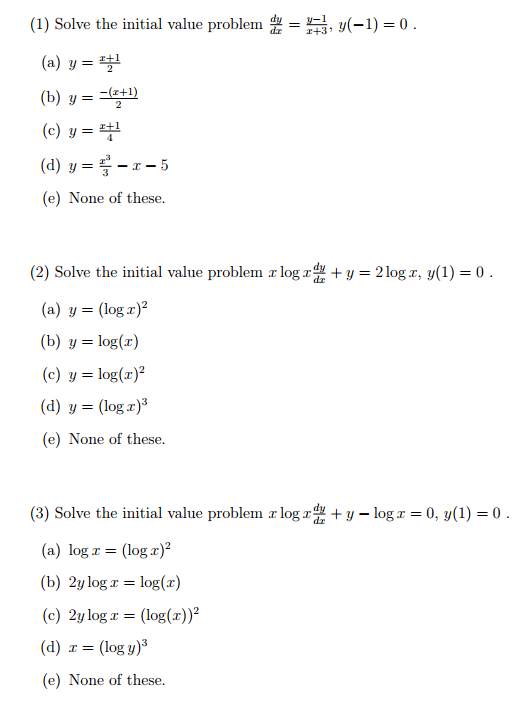



Solve The Initial Value Problem Dy Dx Y 1 X 3 Chegg Com



0 件のコメント:
コメントを投稿